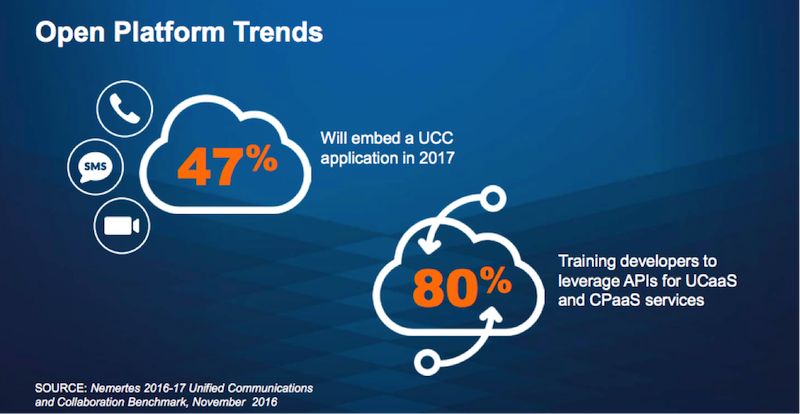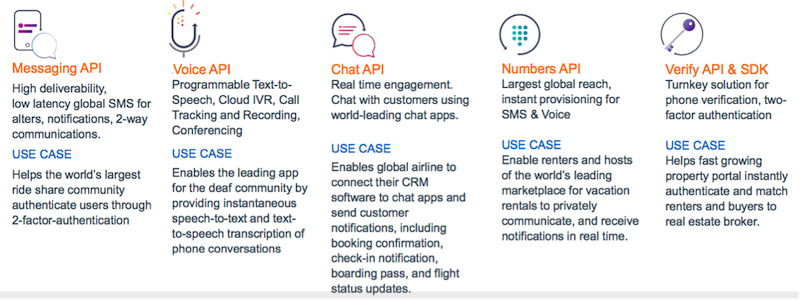UC, API and AI: Where Business Communication Services Go
A couple of months ago, another Enterprise Connect was held - the key conference of the year about cloud technologies in business communications. We comprehended what was happening and made a brief summary of the main trends of 2017. If you are interested, where are the cloud services developing (both SaaS and PaaS) in the USA and what are we going to follow in Russia?

Good old Unified Communications
Continuing movement towards more tight integration on a single cloud platform of all corporate communication channels - texts (chat, mail, joint documents, etc.), telephony (calls, call management, speech recognition, etc.) and conferences ( audio and video). The philosophy of unified communications (UC - Unified Communications) was incorporated into Western business services at the start and continues to be promoted by the main vendors of the industry - Microsoft, Amazon and Google, as well as specialized telecom in the face of Cisco, RingCentral, Univago, etc.
Calls still command the parade.
At the same time, calls remain the main component of UC for several years in a row. And cloud services invest the most part of resources in improvement of work with them.
- Microsoft expands the options for working with them within the Skype for Business tool: Auto Attendant and Call Queues have been announced . The first of the services allows you to automatically answer incoming calls and redirect them online, including using the user's voice recognition system. And the second automatically puts incoming calls in the queue, transferring them to the released operators.
- The same Microsoft announces the planned launch of a call analytics dashboard in Skype for Business - the functionality will collect detailed telemetry data about calls in real time so that the company can quickly solve any technical problems with the connection.
Team play

And yet, the focus in UC in 2017 is slowly shifting towards tools for group communication among employees. Mostly, conferences and chats.
- Amazon continues to fuel interest in the Chime service launched in February . It allows audio and video conferencing in one click. With nice buns in the form of chat, screen sharing and other things that run smoothly on all popular desktop and mobile platforms.
') - Google repositions the Hangouts service, turning it towards the business audience. In focus - video conferencing (the decision of Meet) and group chats (Chats).
- Cisco expands Spark. In addition to the previously announced Spark Board, designed for large-scale video conferencing, a Spark Room appeared for small working meetings of 7 to 14 people. At the same time, Cisco, according to the tradition of the initially “hardware” company, focuses on the hardware component of the service: compatibility with any existing HD display installed in the office intercom is declared. In general, Cisco's philosophy is that we live in a BYOD world (bring your own device), when employees of companies bring their own devices to the office, and the task of business communications services is to be able to work easily with each of them within corporate communications.
- Do not lag behind and solutions based on Microsoft. Yorktel's Univago service has declared itself to be the only solution that makes Skype conferences in Office 365 possible, connecting users to any communication protocol (be it SIP, H.323 or WebRTC).
Webrtc
This story stands out from the rest of the trends in work with calls on a separate line. Communication services go to meet the user and create the opportunity for him to call directly through the browser. This, in general, means that WebRTC is gaining momentum, a technology that allows it to be done without installing any additional applications and softphones.

- Genesys restarts the Genesys Customer Experience Platform and notes two key features of the PureConnect product for call-centers: cobrause (synchronous browsing of the site by the operator and the client communicating with it) and WebRTC (available in Firefox and Chrome on the PC).
- Comcast also follows the trend and announces VoiceEdge for Google Chrome.
API and ready integrations

Another trend-tradition - the development of API-infrastructure. In this case, someone relies on its own integration modules, and someone on universal platforms that are able to establish the interaction of any services on the basis
- A classic example of the first case is RingCentral. The guys are pumping both specialized API methods for different application cases, and direct native integrations with popular business services (CRM, etc.) not only in the USA, but also in Europe. Here the West definitely has a candidate for the title of the king of ready-made integrations - and so an impressive list of solutions such as HubSpot, PipeDrive, Agile CRM or SalesForce, is now supplemented with 8x8.

- The illustration of the second approach is, for example, Masergy, who made a knight's move, starting a part with CloudPipes. The integration aggregator gives access to the integration of opportunities with any other cloud service.
Artificial Intelligence as a Premonition
Of course, not without AI. In the current application in business communications services, these are solutions for predictive analytics, building predictions based on the development of historical data on customer behavior.
In addition, according to the feelings of the industry players, they are about to learn how to use it to improve the technical aspects of call routing, and in the more distant future we will come to stories such as sophisticated contextual routing of calls or AI assistants who will help company employees with working issues group communication channels.
Source: https://habr.com/ru/post/327724/
All Articles